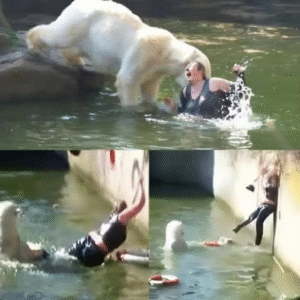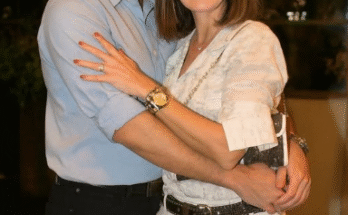Incident at Berlin Zoo: Woman Enters Polar Bear Enclosure
Zoos are meant to be places of wonder—where children press their hands against glass to marvel at lions, where families gather to watch penguins dive gracefully underwater, and where people leave with a sense of connection to the natural world. But every so often, a day of leisure and learning turns into a scene of chaos and shock. Such was the case during the infamous incident at the Berlin Zoo, when a woman inexplicably climbed into the polar bear enclosure, igniting fear, confusion, and ultimately tragedy.
The Ordinary Morning
It was a spring day in Berlin, and the zoo was alive with its usual chorus: the chatter of schoolchildren, the excited pointing of tourists, and the steady hum of families enjoying a weekend outing. At the heart of the zoo stood the polar bear exhibit, home to several of the most popular residents—massive, snow-white creatures whose playful swims and imposing size drew constant crowds.
Among the onlookers that day was a 32-year-old woman, whose name the zoo never released to the public. She had purchased her ticket like everyone else and wandered the grounds for a time. But as noon approached, her actions would shift from curious to unthinkable.
The Leap Into Danger
Witnesses recall seeing the woman climb over the first barrier—a waist-high fence designed to discourage visitors from getting too close. Some assumed she was being reckless, perhaps trying to get a better photograph. But within seconds, she had scaled the second, taller fence, and before anyone could stop her, she jumped down into the moat that separated the spectators from the bears.
Gasps erupted from the crowd. Parents clutched their children. Phones were raised to call for help. But the woman appeared oddly calm, wading through the cold water as if drawn toward the very animals that could kill her in an instant.
On the other side of the moat, four adult polar bears lounged in their rocky habitat. They were magnificent, powerful, and dangerous. Unlike their cartoonish depictions, polar bears are apex predators, capable of taking down seals, walruses, and even humans. Each weighed several hundred pounds and possessed jaws strong enough to crush bone.
The Bears React
At first, the bears seemed indifferent, glancing toward the intruder with mild curiosity. But then instinct took over. One of the bears approached, sniffing the air before lunging with terrifying speed.
The woman screamed as the bear swiped at her, pulling her into the water. The crowd’s horror escalated. Children cried. Adults shouted helplessly. Zoo staff, alerted by panicked visitors, raced to the scene.
A Desperate Rescue
What followed was a frantic attempt to save the woman’s life. Zookeepers, trained for emergencies but rarely facing something so dire, rushed to distract the bears. They used long poles, fired tranquilizer darts, and shouted commands.
Meanwhile, the woman struggled in the water, trying to fend off the bear that now had her arm in its jaws. Blood stained the pool, a shocking contrast to the pale blue water and the white fur of the predator.
It took several minutes—minutes that felt like hours—for staff to finally pull her from the enclosure. She was rushed to safety, her body bloodied but still alive. The bears, once subdued and herded away, returned to their rocky perches, their wild instincts having nearly resulted in tragedy.
The Aftermath
Doctors later confirmed that the woman had suffered severe injuries, including deep bites and lacerations. Miraculously, none were immediately fatal. She was treated in a nearby hospital, where questions about her state of mind soon emerged.
Investigators discovered that the incident had not been a stunt or an accident—it was likely the result of mental health struggles. Reports suggested she had been in psychological distress, raising broader questions about how institutions like zoos should prepare for unpredictable human behavior.
Public Outcry
The event shocked Berlin and reverberated worldwide. Media outlets replayed grainy footage captured by bystanders, showing the surreal moment a human placed herself at the mercy of one of nature’s fiercest predators.
Public opinion was divided. Many expressed outrage at the woman, calling her actions irresponsible and selfish, not only endangering her own life but also risking harm to the bears. Others expressed sympathy, noting that her behavior was likely driven by personal struggles rather than malice.
Above all, there was gratitude toward the zoo staff whose quick action prevented the tragedy from becoming fatal. Their bravery in facing down four polar bears with little more than poles and tranquilizer guns drew widespread praise.
The Bears’ Perspective
Perhaps the most troubling aspect of the incident was the fate of the bears themselves. In similar situations at other zoos around the world, animals have often been euthanized after human intrusions, seen as too great a risk to public safety.
Thankfully, in this case, the Berlin Zoo made it clear that the bears had done nothing wrong. They were simply responding to instincts. No disciplinary action was taken against the animals, and they remained in the enclosure after the event. Still, the incident sparked broader debates about the ethics of captivity and the responsibility of humans toward wild creatures.
Lessons Learned
The Berlin Zoo tightened its security measures after the incident, adding taller barriers, more surveillance, and additional training for emergency response. But the event highlighted a difficult truth: no enclosure, however well-designed, can account for human unpredictability.
It also underscored the need for compassion toward those struggling with mental health. The woman’s leap into the enclosure was not an act of thrill-seeking but a cry for help, one that nearly cost her life and could have led to the destruction of innocent animals.
A Lasting Reminder
Years later, the incident remains etched in memory not because of the spectacle but because of the deeper questions it raised. Why are humans drawn so powerfully to animals that could harm us? What compels someone to cross boundaries meant for their own protection? And how do we balance the need for human safety with the dignity of creatures kept in captivity for our education and entertainment?
The polar bears of the Berlin Zoo continue to live out their days under the watchful eyes of visitors, who now view the barriers with a new respect. The woman survived, her story a chilling reminder of both the fragility of human life and the untamable power of nature.
Conclusion
The Berlin Zoo incident was more than a shocking headline—it was a confrontation with the limits of human control. In that moment when a woman stood face-to-face with a polar bear, the illusion of safety shattered, replaced by the raw reality of nature’s might.
It was a near-tragedy born of desperation, but it ended with survival, hard questions, and an enduring reminder: wild animals are not ours to test. Their strength demands respect, their space demands distance, and when those boundaries are crossed, the consequences can be devastating.
In the end, the story is not just about one woman or one zoo. It is about the fragile line between wonder and danger, curiosity and recklessness, life and death. And it is a story that reminds us—sometimes painfully—why barriers exist in the first place.


